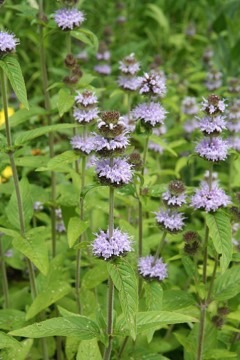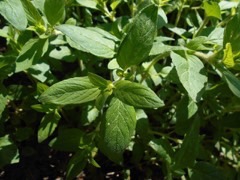 |
|
Michael Wolf, Penig wikimedia.org |
 |
| Salicyna wikimedia.org |
Translate this page:
Summary
Physical Characteristics

 Blephilia ciliata is a PERENNIAL growing to 0.7 m (2ft 4in) by 0.4 m (1ft 4in) at a fast rate.
Blephilia ciliata is a PERENNIAL growing to 0.7 m (2ft 4in) by 0.4 m (1ft 4in) at a fast rate.
See above for USDA hardiness. It is hardy to UK zone 4. The flowers are pollinated by Bees, Insects.
Suitable for: light (sandy) and medium (loamy) soils and prefers well-drained soil. Suitable pH: mildly acid and neutral soils and can grow in very acid soils.
It can grow in semi-shade (light woodland) or no shade. It prefers dry or moist soil and can tolerate drought.
UK Hardiness Map
US Hardiness Map
Synonyms
B. brevifolia Raf. B. ciliata f. ciliata. B. heterophyla Raf. B. pratensis Raf. Monarda beckii Eaton. Monarda ciliata L.
Plant Habitats
Edible Uses
Edible Parts: Leaves
Edible Uses:
Leaves. Minty leaves eaten raw and used in teas. The leaves can be used to prepare sauces and drinks [1-4].
References More on Edible Uses
Medicinal Uses
Plants For A Future can not take any responsibility for any adverse effects from the use of plants. Always seek advice from a professional before using a plant medicinally.
Traditionally used by the Cherokee to make a poultice to treat headaches.
References More on Medicinal Uses
The Bookshop: Edible Plant Books
Our Latest books on Perennial Plants For Food Forests and Permaculture Gardens in paperback or digital formats.

Edible Tropical Plants
Food Forest Plants for Hotter Conditions: 250+ Plants For Tropical Food Forests & Permaculture Gardens.
More

Edible Temperate Plants
Plants for Your Food Forest: 500 Plants for Temperate Food Forests & Permaculture Gardens.
More

More Books
PFAF have eight books available in paperback and digital formats. Browse the shop for more information.
Shop Now
Other Uses
Soil stabilization
A strong scented plant that may act as an aromatic pest confuser reducing their ability to find other nearby crops [1-3]. The flowers attract long-tongued and short-tongued bees, bee flies, Syrphid flies, butterflies, and skippers (illinoiswildflowers.info). A plant for Forest Gardens, Pollinator Gardens, Prairie or Meadow. Used as Butterfly Nectar Plants or as part of a Groundcover or Mass Planting. Showy Blooms can be used in Cottage Gardens, Deer Resistant Plantings, Rock Gardens, Water-wise Landscapes, Low Maintenance Plantings, Perennial Borders, Restoration Projects and Wildlife Gardens (newmoonnursery.com).
Special Uses
Attracts Wildlife Food Forest Ground Cover
References More on Other Uses
Cultivation details
A Short-Lived fast-growing herbaceous perennial with an upright form. It prefers full sun to semi-shade and a loamy, silty soil with a pH 6 to 8. Downy wood mint has some drought tolerance but dislikes waterlogged soils or flooding. It is sensitive to salt, soil compaction. Flowers are fragrant. Soil can contain loam, clay, gravel and limestone. A high pH is tolerated but will restrict growth. It has a greater tolerance to drought than other mint species. For polyculture design as well as the above-ground architecture (form - tree, shrub etc. and size shown above) information on the habit and root pattern is also useful and given here if available. The plant growth habit is a clumper with limited spread [1-2]. Root type is fibrous and shallow. Flowering time: June to August (Northern Hemisphere).
References Carbon Farming Information and Carbon Sequestration Information
Temperature Converter
Type a value in the Celsius field to convert the value to Fahrenheit:
Fahrenheit:
The PFAF Bookshop
Plants For A Future have a number of books available in paperback and digital form. Book titles include Edible Plants, Edible Perennials, Edible Trees,Edible Shrubs, Woodland Gardening, and Temperate Food Forest Plants. Our new book is Food Forest Plants For Hotter Conditions (Tropical and Sub-Tropical).
Shop Now
Plant Propagation
Propagate by division.
Other Names
If available other names are mentioned here
Downy pagoda plant, sunny woodmint and Ohio horsemint.
Native Range
NORTHERN AMERICA: Canada, Ontario (south), United States, Connecticut, Indiana, Massachusetts (west), Michigan (south), New York, Ohio, Pennsylvania, Vermont, West Virginia, Illinois, Iowa, Kansas (southeast), Missouri, Oklahoma (east), Wisconsin (south), Alabama, Arkansas, Delaware, Georgia, Kentucky, Maryland, Mississippi, North Carolina, South Carolina, Tennessee, Virginia,
Weed Potential
Right plant wrong place. We are currently updating this section.
Please note that a plant may be invasive in one area but may not in your area so it's worth checking.
None Known
Conservation Status
IUCN Red List of Threatened Plants Status :

Growth: S = slow M = medium F = fast. Soil: L = light (sandy) M = medium H = heavy (clay). pH: A = acid N = neutral B = basic (alkaline). Shade: F = full shade S = semi-shade N = no shade. Moisture: D = dry M = Moist We = wet Wa = water.
Now available:
Food Forest Plants for Mediterranean Conditions
350+ Perennial Plants For Mediterranean and Drier Food Forests and Permaculture Gardens.
[Paperback and eBook]
This is the third in Plants For A Future's series of plant guides for food forests tailored to
specific climate zones. Following volumes on temperate and tropical ecosystems, this book focuses
on species suited to Mediterranean conditions—regions with hot, dry summers and cool, wet winters,
often facing the added challenge of climate change.
Read More
Expert comment
Author
(L.) Benth.
Botanical References
Links / References
For a list of references used on this page please go here
Readers comment
| Add a comment |
|
If you have important information about this plant that may help other users please add a comment or link below. Only comments or links that are felt to be directly relevant to a plant will be included. If you think a comment/link or information contained on this page is inaccurate or misleading we would welcome your feedback at [email protected]. If you have questions about a plant please use the Forum on this website as we do not have the resources to answer questions ourselves.
* Please note: the comments by website users are not necessarily those held by PFAF and may give misleading or inaccurate information.
To leave a comment please Register or login here All comments need to be approved so will not appear immediately.
|
Subject : Blephilia ciliata
|
|
|
|